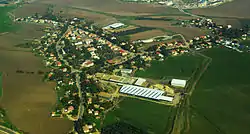Beit Hilkia
Beit Hilkia (Hebrew: בֵּית חִלְקִיָּה, lit. House of Hilkia) is a Haredi moshav in central Israel. Located in the Shephelah near Gedera, it falls under the jurisdiction of Nahal Sorek Regional Council. In 2021 it had a population of 1,446.[1]
Beit Hilkia
בֵּית חִלְקִיָּה | |
|---|---|
 | |
 Beit Hilkia  Beit Hilkia | |
| Coordinates: 31°47′27″N 34°48′44″E | |
| Country | |
| District | Central |
| Council | Nahal Sorek |
| Affiliation | Poalei Agudat Yisrael |
| Founded | 1953 |
| Founded by | Former Jerusalem and ma'abarot residents |
| Population (2021)[1] | 1,446 |
History
The village was established in 1953 by former residents of Jerusalem and ma'abarot who wanted to combine a Haredi and agricultural lifestyle. It is named after Hilkia, the father of the prophet Jeremiah (Jeremiah 1:1).[2][3][4]
It was established on land that had belonged to the depopulated Palestinian village of Al-Mukhayzin.[5]
Archaeology
In 2015, a salvage excavation brought to light a prehistoric site near Beit Hilkia and the Revivim quarry, with findings from the Pottery Neolithic (Yarmukian), Late Chalcolithic, and the Middle Bronze Age IIA–IIB.[6] Somewhat surprising was the discovery of a typical Yarmukian-style fired clay figurine of a fertility goddess, the southernmost such finding.[6] Of 163 found up to that date, the vast majority had been discovered in the main area known for its Yarmukian settlements, in and around the northern type-site of Sha'ar HaGolan, with just two exceptions further to the south.[6] This new finding led to speculations that much of the Southern Levant might have been inhabited by a contiguous civilization during the time (c. 6400–6000 BCE), with differences in pottery types being more significant to today's archaeologists than to people living back then.[6]
References
- "Regional Statistics". Israel Central Bureau of Statistics. Retrieved 22 February 2023.
- Carta (1993). Carta's Official Guide to Israel and Complete Gazetteer to all Sites in the Holy Land (3rd ed.). Carta. p. 111. ISBN 965-220-186-3.
- Place Names in Israel. A Compendium of Place Names in Israel compiled from various sources, p256
- Bitan, Channah (1999). חמישים שנות התיישבות : אטלס שמות היישובים והמקומות בישראל [Fifty Years of 'Hityashvut:' Atlas of Names of Settlements in Israel] (in Hebrew). Carta. p. 10. ISBN 9789652204233.
- Khalidi, Walid (1992), All That Remains: The Palestinian Villages Occupied and Depopulated by Israel in 1948, Washington D.C.: Institute for Palestine Studies, p. 398, ISBN 0-88728-224-5
- Marmelstein, Yitzhak; van den Brink, Edwin C.M. (26 July 2020). "Bet Hilqiya: Preliminary report". Hadashot Arkheologiyot. Jerusalem: Israel Antiquities Authority. 132. Retrieved 26 May 2021.